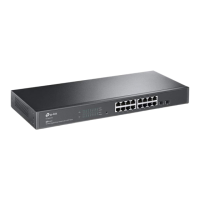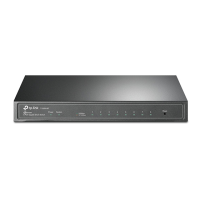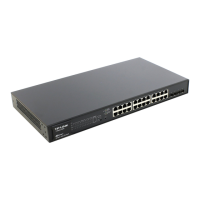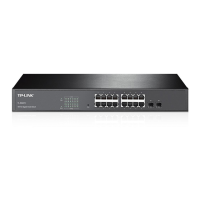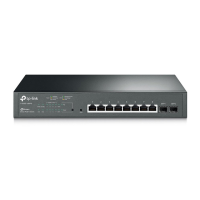Do you have a question about the TP-Link T1700G-28TQ and is the answer not in the manual?
Provides a summary of the switch's features, design, and capabilities.
Details the physical components and layout of the switch's front and rear panels.
Step-by-step guide on accessing the switch's web management interface.
Overview of the main setup menu and navigation within the web interface.
Covers viewing system summary, device details, time, DST, and IPv6 settings.
Explains how to configure user accounts, access levels, and passwords for management.
Covers boot configuration, config restore/backup, firmware upgrades, and system reset.
Details security measures for remote login, including Access Control, HTTP, HTTPS, and SSH.
Describes how to configure SDM templates for managing switch resources.
Covers stack elements, roles, events, and operational procedures for managing stacked switches.
Illustrates a practical scenario for setting up a ring topology stack with multiple switches.
Details basic port settings like speed, duplex, flow control, and jumbo frames.
Explains LAG for combining ports to increase bandwidth and reliability.
Covers monitoring traffic summaries and detailed statistics for each port.
Details managing static, dynamic, and filtering MAC address entries for network security.
Explains VLAN tagging, port types, PVID, and VLAN configuration procedures.
Provides practical examples for implementing 802.1Q and MAC VLANs in network scenarios.
Describes classifying VLANs based on MAC addresses for specific host access control.
Illustrates a practical scenario for configuring MAC VLANs with specific host access.
Covers classifying VLANs based on network protocols like IP, IPX, and ARP.
Demonstrates configuring Protocol VLANs for managing network traffic by protocol type.
Details STP modes (STP, RSTP, MSTP), timers, and global parameters.
Covers port configuration parameters like status, priority, path costs, and roles within STP.
Explains MSTP regions, instances, and port configurations for load balancing and redundancy.
Details protection features like Port Protect, Root Protect, TC Protect, BPDU Protect, and BPDU Filter.
Covers IGMP snooping, messages, ports, timers, and configuration options for multicast control.
Details MLD snooping for IPv6 multicast, including snooping, ports, VLANs, and multicast VLANs.
Explains viewing and configuring IPv4/IPv6 multicast IP addresses and tables.
Describes configuring Layer 3 interfaces, IP addressing modes, and secondary IP addresses.
Provides information on viewing the routing table and understanding routing protocols.
Details manual configuration of static routes for network traffic management.
Covers ARP table viewing, static ARP configuration, and ARP scanning for network mapping.
Explains traffic classification, priority mapping (Port, 802.1P, DSCP), and scheduling modes.
Details rate limiting and storm control features for managing traffic rates on ports.
Covers configuring Voice VLANs for voice data streams, OUI addresses, and security modes.
Describes creating and managing time-ranges and holidays for conditional ACL application.
Covers configuring MAC ACL, Standard-IP ACL, and Extend-IP ACL rules for packet filtering.
Explains creating policies by combining ACLs with actions for traffic control.
Details binding ACLs and policies to specific ports or VLANs for effective control.
Covers IP-MAC binding methods and ARP scanning for network access control and security.
Explains DHCP snooping, global and port configurations to prevent rogue DHCP servers.
Details ARP inspection features like ARP Detect, ARP Defend, and ARP Statistics to prevent attacks.
Covers enabling DoS defense types to protect against various Denial of Service attacks.
Explains 802.1X authentication architecture, procedure, and configuration (Global, Port, RADIUS).
Covers SNMP configuration, views, groups, users, and communities for network management.
Details configuring SNMP Traps and Informs for network event notifications to a management station.
Explains RMON groups (Statistics, History, Event, Alarm) for detailed network performance monitoring.
Covers monitoring CPU and Memory utilization rates for system performance and security.
Details configuring log output channels (buffer, file) and managing system logs.
Explains using Cable Test for diagnosing physical cable connection issues.
Covers using Ping and Tracert tests for network connectivity and troubleshooting.
Provides a summary of the switch's features, design, and capabilities.
Details the physical components and layout of the switch's front and rear panels.
Step-by-step guide on accessing the switch's web management interface.
Overview of the main setup menu and navigation within the web interface.
Covers viewing system summary, device details, time, DST, and IPv6 settings.
Explains how to configure user accounts, access levels, and passwords for management.
Covers boot configuration, config restore/backup, firmware upgrades, and system reset.
Details security measures for remote login, including Access Control, HTTP, HTTPS, and SSH.
Describes how to configure SDM templates for managing switch resources.
Covers stack elements, roles, events, and operational procedures for managing stacked switches.
Illustrates a practical scenario for setting up a ring topology stack with multiple switches.
Details basic port settings like speed, duplex, flow control, and jumbo frames.
Explains LAG for combining ports to increase bandwidth and reliability.
Covers monitoring traffic summaries and detailed statistics for each port.
Details managing static, dynamic, and filtering MAC address entries for network security.
Explains VLAN tagging, port types, PVID, and VLAN configuration procedures.
Provides practical examples for implementing 802.1Q and MAC VLANs in network scenarios.
Describes classifying VLANs based on MAC addresses for specific host access control.
Illustrates a practical scenario for configuring MAC VLANs with specific host access.
Covers classifying VLANs based on network protocols like IP, IPX, and ARP.
Demonstrates configuring Protocol VLANs for managing network traffic by protocol type.
Details STP modes (STP, RSTP, MSTP), timers, and global parameters.
Covers port configuration parameters like status, priority, path costs, and roles within STP.
Explains MSTP regions, instances, and port configurations for load balancing and redundancy.
Details protection features like Port Protect, Root Protect, TC Protect, BPDU Protect, and BPDU Filter.
Covers IGMP snooping, messages, ports, timers, and configuration options for multicast control.
Details MLD snooping for IPv6 multicast, including snooping, ports, VLANs, and multicast VLANs.
Explains viewing and configuring IPv4/IPv6 multicast IP addresses and tables.
Describes configuring Layer 3 interfaces, IP addressing modes, and secondary IP addresses.
Provides information on viewing the routing table and understanding routing protocols.
Details manual configuration of static routes for network traffic management.
Covers ARP table viewing, static ARP configuration, and ARP scanning for network mapping.
Explains traffic classification, priority mapping (Port, 802.1P, DSCP), and scheduling modes.
Details rate limiting and storm control features for managing traffic rates on ports.
Covers configuring Voice VLANs for voice data streams, OUI addresses, and security modes.
Describes creating and managing time-ranges and holidays for conditional ACL application.
Covers configuring MAC ACL, Standard-IP ACL, and Extend-IP ACL rules for packet filtering.
Explains creating policies by combining ACLs with actions for traffic control.
Details binding ACLs and policies to specific ports or VLANs for effective control.
Covers IP-MAC binding methods and ARP scanning for network access control and security.
Explains DHCP snooping, global and port configurations to prevent rogue DHCP servers.
Details ARP inspection features like ARP Detect, ARP Defend, and ARP Statistics to prevent attacks.
Covers enabling DoS defense types to protect against various Denial of Service attacks.
Explains 802.1X authentication architecture, procedure, and configuration (Global, Port, RADIUS).
Covers SNMP configuration, views, groups, users, and communities for network management.
Details configuring SNMP Traps and Informs for network event notifications to a management station.
Explains RMON groups (Statistics, History, Event, Alarm) for detailed network performance monitoring.
Covers monitoring CPU and Memory utilization rates for system performance and security.
Details configuring log output channels (buffer, file) and managing system logs.
Explains using Cable Test for diagnosing physical cable connection issues.
Covers using Ping and Tracert tests for network connectivity and troubleshooting.
| Switch type | Managed |
|---|---|
| Switch layer | L2/L2+ |
| Form factor | 1U |
| Product color | Black |
| SFP+ module slots quantity | 4 |
| Installed SFP modules quantity | - |
| Basic switching RJ-45 Ethernet ports type | Gigabit Ethernet (10/100/1000) |
| Basic switching RJ-45 Ethernet ports quantity | 24 |
| Physical stacking (units) | 6 |
| Compatible operating systems | Microsoft Windows XP, Vista, Windows 7, Windows 8/8.1, MAC OS, NetWare, UNIX, Linux |
| Number of VLANs | 4000 |
| Networking standards | IEEE 802.1D, IEEE 802.1Q, IEEE 802.1p, IEEE 802.1s, IEEE 802.1w, IEEE 802.1x, IEEE 802.3ab, IEEE 802.3ad, IEEE 802.3ae, IEEE 802.3az, IEEE 802.3i, IEEE 802.3u, IEEE 802.3x, IEEE 802.3z |
| Virtual LAN features | Voice VLAN, Protocol-based VLAN, MAC address-based VLAN |
| Cable types supported | Cat5, Cat5e |
| Copper ethernet cabling technology | 10BASE-T, 100BASE-TX, 1000BASE-LX, 1000BASE-TX, 1000BASE-T |
| DHCP features | DHCP snooping, DHCP relay, DHCP client |
| Security algorithms | HTTPS, SNMP, SSH, SSH-2, SSL/TLS |
| Queue scheduling algorithms | SP, WRR+SP, Weighted Round Robin (WRR) |
| Jumbo frames | 9000 |
| Forwarding rate | 95.2 Mpps |
| Number of queues | 8 |
| Jumbo frame range | - B |
| MAC address table | 16000 entries |
| Number of IP interfaces | 16 |
| Number of static routes | 32 |
| Storage temperature (T-T) | -40 - 70 °C |
| Operating temperature (T-T) | 0 - 40 °C |
| Storage relative humidity (H-H) | 5 - 90 % |
| Operating relative humidity (H-H) | 10 - 90 % |
| Package depth | 250 mm |
| Package width | 528 mm |
| Package height | 80 mm |
| Cables included | AC |
| AC input voltage | 100 - 240 V |
| AC input frequency | 50 - 60 Hz |
| Power consumption (max) | 21.8 W |
| Depth | 180 mm |
|---|---|
| Width | 440 mm |
| Height | 44 mm |
| Weight | 2800 g |





